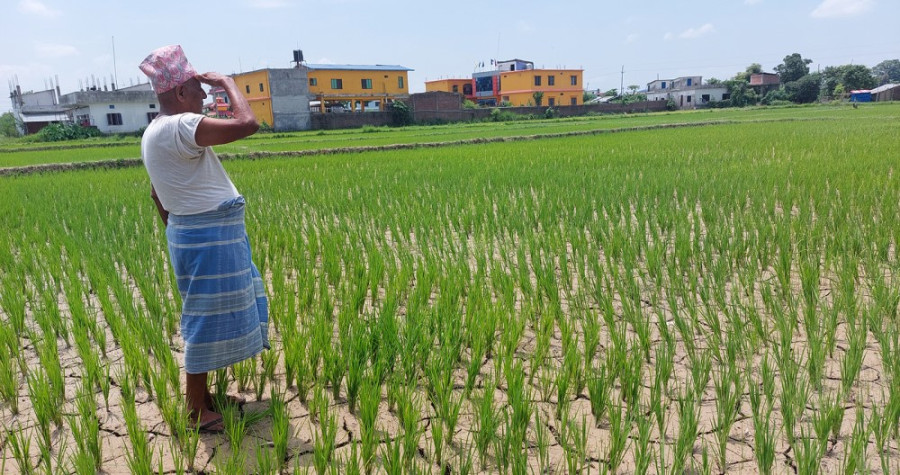Columns
When is the next rain?
Beyond the environmental toll, droughts amplify inequalities and threaten livelihoods.
Madhukar Upadhya
On Balachadurdashi, the day in November when grieving families commemorate their loved ones who passed away that year, hundreds gather to stay up all night, lighting oil lamps, circumambulating holy shrines of Lord Shiva in the morning to broadcast the seeds of seven kinds of cereal (sata beej) and pray for the eternal peace of the departed souls. Gloomy and cloudy, the day would mark the arrival of winter rains in Nepal. The Balachadurdashi rain would also bring frosty weather to Kathmandu Valley, followed by much colder days in January and February, characterised by incessant winter rain. However, things changed this past year. We didn’t get any rain on the day of Balachadurdashi; thus, this winter has been fairly mild. We haven't had any rain yet despite being halfway through February.
Unsurprisingly, this isn't the first time that winter rain has failed us. Records show that Nepal has been experiencing consecutive winter drought conditions since 2000. There've been at least four dry winters in the decade that followed: 2005-06, 2007-08, 2008-09 and 2009-10. The most striking was that of 2008-09 because not only was it one of the worst on record, but it also followed the global food crisis of 2008 and the failure of winter crops heightened concerns about food security. The winter of 2020-21 was the driest season on record which also elevated air pollution in Kathmandu to its worst levels.
Damaging droughts
Unlike floods, which are generally confined to a particular area, droughts cause a whole host of extensive problems simultaneously from crop loss to a decline in dairy production to drying of water sources to increased likelihood of forest fires. A prolonged winter drought can result in a rising haze, even limiting the visibility of aircraft.
A balance between summer and winter rain is crucial for national food security because any complications in the summer monsoon, such as floods or delayed arrival of rain, affecting summer crop production can be compensated by winter crops if we get adequate and timely winter rain. For example, in 2021, we had late monsoon rain in October that severely damaged ready-to-harvest paddy; however, timely winter rain in January 2022 meant wheat crops provided some relief to farmers. But the 2022 winter has been drastically different. The late monsoon rain damaged some paddy, and it hasn’t rained since. Wheat and mustard crops in rain-fed farms have already been badly affected by the lack of rainwater.
Droughts have been a common phenomenon in this part of the world; they have a long history in the region too. A drought in 1919 was so brutal that many had to emigrate for employment because of consistent crop failures. Nepal’s population declined in the following years until 1930. The historical droughts were probably caused by inter-decadal or even inter-centennial variations in global weather patterns. However, a common question that people ask now is: Why has winter rain started to fail so often? And how worrisome is the increased frequency of winter drought? And, more importantly, what can we expect in the years ahead?
Understanding of global weather and climate systems has developed substantially in the last decades, and it's well established that weather changes are linked. Following the 2008-09 drought, a study was conducted by climate scientists from Utah State University to understand the causes of winter drought in western Nepal. The results indicate some of these teleconnections and offer some probable scientific explanations for the increased frequency of winter droughts. We're seeing the interplay of three distinct but interrelated forces. The first factor is the obscene amounts of aerosol load in the Indo-Gangetic plain, which continues to rise unchecked, impacting the temperature gradient and affecting weather patterns in the region. We're also witnessing the second factor—the Indian Ocean is getting warmer—which is likely to contribute to the suppression of rainfall through enhanced subsidence of local Hadley circulation (atmospheric circulation) over much of Nepal. And third, and perhaps most important, is Artic Oscillation—the shifting of atmospheric pressure between the polar area and the mid-latitudes and its variability. It’s well-understood that the temperature at the poles is rising faster than anywhere else on the planet due to global warming. This rise in polar temperature has a bearing on the relationship between the polar vortex (area of high-speed, cyclonically rotating winds in the polar regions) and the jet stream (narrow band of strong winds in the upper atmosphere).
This delicate dance between the two is maintained as long as the jet stream stays strong and the polar vortex remains within its confines. When the jet stream weakens, the polar vortex expands and moves to the mid-latitudes. Interestingly (or perhaps alarmingly), the study found that when the jet stream begins to meander with prominent negative phases, it eventually affects the western disturbance causing suppression of winter rain in the western part of Nepal. And, unlike the monsoon rain which enters Nepal from the eastern side, the winter rain is brought in by the western disturbance in the corresponding part of Nepal. Therefore, when the atmospheric system suppresses rainfall in western Nepal, as is happening this year, it not only causes drought in western Nepal but also leaves the rest of the country dry since western Nepal is the gateway for winter rain.
Frequent droughts
The study suggests that the concurrence of a negative Arctic Oscillation phase with the ongoing tendencies of the Indian Ocean warming and aerosol loading is likely to heighten the suppression of rainfall, leading to persistent or even more frequent droughts in the years ahead. The study also pointed out that while groundwater has hardly been replenished during the summer for various reasons and with declining winter precipitation, management of water resources should be prioritised in development work in the years ahead.
The ongoing drought may even have greater repercussions than 2008-09 because food prices are already on the rise due to the Russia-Ukraine war, and it's likely to further weaken the prospects of economic growth which have barely begun recovering since the pandemic. Frequent droughts affect everyone; beyond the environmental toll, they amplify existing inequalities, posing serious threats to the livelihoods and safety of marginalised groups with limited access to technology or resources. Therefore, in the context of a falling groundwater table and rising temperature exacerbating drought conditions, if planners want to formulate strategies to respond to these problems, they must have an understanding of the complex, multi-layered and varied impacts that droughts have on them.




 16.12°C Kathmandu
16.12°C Kathmandu














